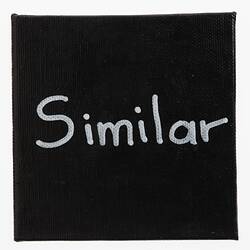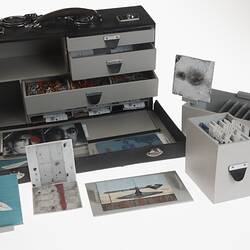Summary
Artwork entitled 'Similar', created in 2015 by Melbourne-based Colombian refugee, Carmenza Jimenez Osorio. It is part of 'Attache Case', a collective artwork co-ordinated by Peter Burke in 2015. Carmenza also created another artwork in this collection: 'Similar' (HT56009.7).
Artist statement provided by Carmenza in Spanish and English in 2021:
'"Similar" is a word that is spelled the same in English and Spanish and also has the same meaning. I have found hundreds of words that are spelled the same in both languages and maintain the same meaning. The difference is only in the pronunciation. Which means that, as long as there is no sound, the word belongs to both linguistic cultures. We are one in the word. We get separated when we utter sounds. We highlight our differences when we speak. Unfortunately, many people react to the "accent" and automatically make a difference between one and another. "Similar", in black and white, shows us the difference and at the same time the similarity. Which side are you on? Which one is you? The answer is subjective, as subjective is the idea of discriminating a person only because of his or her linguistic accent.'
'I was born in Colombia 63 years ago. I studied journalism, because making a living from painting was not a viable option (it still isn't). The civil war and the presence of paramilitaries forced me to leave my country with part of my family, and after a 3-year journey in El Salvador, we managed to obtain a visa to enter Australia. Once here I studied visual arts and obtained a degree and a master's in fine arts at RMIT. In Australia it is also not very feasible to make a living from painting, so I am currently working as an Integration Children Aide at Collingwood College, and as a journalist at SBS Radio, where I am a Spanish Producer.'
'Nací en Colombia hace 63 años. Estudié periodismo, porque vivir de la pintura no era una opción viable (todavía no lo es). La guerra civil y la presencia de paramilitares me obligaron a dejar mi país con parte de mi familia y después de un periplo de 3 años en El Salvador, logramos obtener la visa para ingresar a Australia. Una vez aquí estudié artes visuales y obtuve un grado y un Máster en bellas artes, en RMIT. En Australia tampoco es muy factible vivir de las pinturas, así que actualmente trabajo como Integracion Children Aide en Collingwood College, y como periodista en SBS Radio, donde soy una Spanish Producer.'
This collective artwork, entitled 'Attache Case' (HT56009), was created by Melbourne artist, curator and lecturer Peter Burke in 2015 as part of an international touring art installation, 'Low-Cost Diplomatic Bag', auspiced by the Spanish Embassy, and curated by Nilo Casares and ArtEx Madrid. It travelled to the Spanish Embassies in five countries, including Australia, in 2015-2016 (one venue included Immigration Museum, Melbourne). 'Attache Case' is comprised of a re-purposed doctor's medical case which opens to reveal small drawers containing 41 individuals' miniature artworks representing 21 refugees from Afghanistan, Vietnam, Poland, Colombia, Sri Lanka, Iran, Egypt and Iraq.
The artworks inside the case are acrylic and oil paintings and collage works on canvas board and copper. Many artworks have handwritten descriptions on paper by the artists on the reverse. The collection also includes a video about the project by César Espada produced in 2015.
Physical Description
Acrylic & fineliner on canvas board. The word 'Similar' is written with a white fine liner marker on a black background.
Significance
'Attache Case' is a collective artwork created in 2015 in response to an invitation by artist, Peter Burke, to a number of asylum seekers and refugees in Melbourne to express their experience visually. The refugees and asylum seekers (some in detention at the time of the project) who produced the artworks came from diverse countries including Afghanistan, Vietnam, Poland, Hungary, Colombia, Sri Lanka, Iran, Egypt and Iraq. They explore diverse themes relating to detainment, immigration, border security policies, bureaucracy, and mental health.
The artists convey thoughts and feelings about freedom, opprtunities, life in Australia, resettlement, optimism, despair, grief, hope, fear and anger and the consequences of living in limbo. These refugee and asylum seeker's voices, concerns, and personal perspectives are not often publicly expressed and more often manipulated by media and politics or silenced in their community.
This complex artwork contains a diversity of cultures, genders, experiences, artistic styles, and responses. The oil and acrylic paintings are objects rich with symbolic meaning - both as a part of a luggage item reminiscent of the migrant experience, as well as a traveller's borderless container (representing migration, diplomacy, policy and bureaucracy) of voices that speak to the issues that are at the heart of the asylum seeker situation and debate.
More Information
-
Collecting Areas
-
Artist
Carmenza Jiminez Osorio, Melbourne, Victoria, Australia, 2015
-
Creator
-
Inscriptions
Reverse side [handwritten]: ' CARMENZA JIMENEZ/ 'Similar'/ Acrylic-colour MARKER/ CARZA/15/2015/ [typed on paper and pasted onto canvasboard backside:] 'SIMILAR' is part of the series 'BORDERS' which/ addresses subjects related to political, physical, social/ and cultural divisions. I've selected a list of words that/ have same spelling...and same meaning both in/ Spanish and in English. At first glance, the words are/neutral... But at the moment that we utter the words,/the sounds evidence the difference.'
-
Classification
Cultural identity, Ethnicity - creative practice, Mixed media
-
Category
-
Discipline
-
Type of item
-
Overall Dimensions
100 mm (Length), 100 mm (Width)
-
Keywords
Refugees, Artists, Artistic Practices, Artworks, Immigration Debates, Immigration Selection, Immigration, Luggage, Detention Centres, Activism, Politics, Ethnic Groups, Colombian Communities, Colombian Immigration



